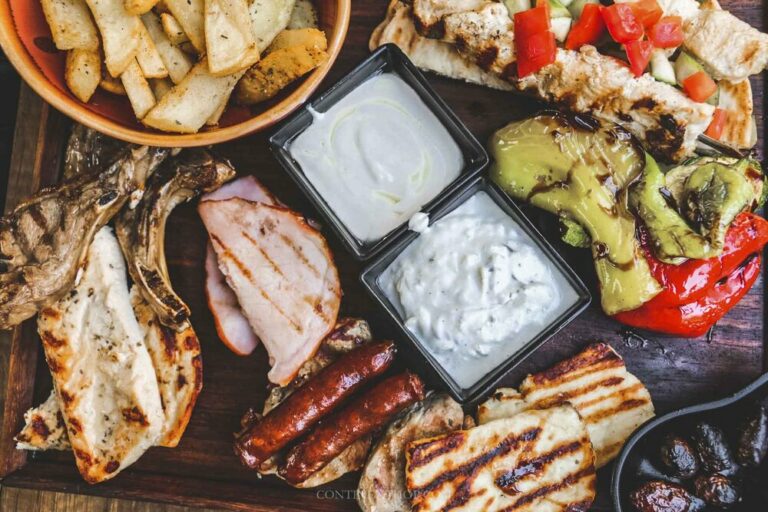Introduction: Cypriot cuisine in a nutshell
Cypriot cuisine is a blend of Greek, Turkish, and Middle Eastern influences, shaped by the island’s history and geographical location. The cuisine is characterized by the use of fresh local ingredients, including vegetables, fruits, herbs, and spices, as well as meat and fish. Cyprus is also known for its traditional drinks, such as zivania, a strong alcoholic beverage made from grapes, and commandaria, a sweet dessert wine.
Traditional dishes of Cyprus: a brief overview
Cypriot cuisine is diverse and includes a wide range of dishes that vary from region to region. Some of the most popular traditional dishes in Cyprus are kleftiko, a slow-cooked lamb dish with potatoes and vegetables, moussaka, a layered dish with eggplant, minced meat, and béchamel sauce, and souvlaki, grilled meat skewers served with pita bread and tzatziki. Other notable dishes include halloumi, a semi-hard cheese made from goat and sheep’s milk, and pasteli, a sesame seed and honey bar.
What makes a signature dish?
A signature dish is a unique and iconic dish that is closely associated with a specific cuisine, region, or culture. It is a dish that reflects the history, traditions, and flavors of the place where it originated. A signature dish can be simple or complex, but it always has a certain authenticity and cultural significance.
The role of cultural heritage in Cypriot cuisine
Cypriot cuisine is deeply rooted in the island’s cultural heritage, which dates back to ancient times. The cuisine has been shaped by various influences over the centuries, including Greek, Turkish, Venetian, and British. Cypriot cuisine reflects the island’s history and the diversity of its people, who have contributed to the development of the cuisine through their unique culinary traditions. The cuisine is an important part of the island’s cultural identity and is celebrated at festivals, fairs, and other events throughout the year.
Popular Cypriot dishes and their origins
Many popular Cypriot dishes have their origins in Greek, Turkish, and Middle Eastern cuisine. For example, kleftiko is believed to have originated in Greece, while moussaka is thought to have originated in the Middle East. Halloumi cheese is a unique Cypriot product, while pasteli is a traditional Cypriot sweet. Souvlaki, on the other hand, is a popular dish throughout the Mediterranean region.
Discovering the unique flavors of Cypriot cuisine
Cypriot cuisine is characterized by the use of fresh, local ingredients, such as vegetables, fruits, herbs, and spices. The cuisine also features a variety of meats, including lamb, pork, and chicken, as well as fish and seafood. Cypriot cuisine is known for its bold flavors and unique combinations, such as the pairing of halloumi cheese with watermelon or the use of cinnamon and allspice in savory dishes.
Is there a single signature dish in Cypriot cuisine?
While there are many popular and iconic dishes in Cypriot cuisine, it is difficult to pinpoint a single signature dish. This is because Cypriot cuisine is so diverse and reflects a variety of cultural influences. However, some might argue that kleftiko, with its slow-cooked lamb, potatoes, and vegetables, is the closest thing to a signature dish in Cypriot cuisine.
Conclusion: the diversity and richness of Cypriot gastronomy
Cypriot cuisine is a rich and diverse blend of Greek, Turkish, and Middle Eastern influences, shaped by the island’s history and geography. The cuisine reflects the island’s cultural heritage and the diversity of its people, who have contributed to the development of the cuisine through their unique culinary traditions. While there is no single signature dish in Cypriot cuisine, the cuisine is known for its bold flavors, unique combinations, and use of fresh, local ingredients.






